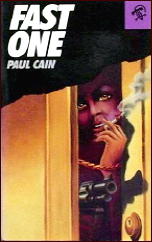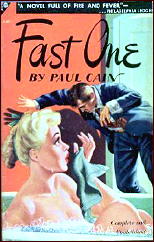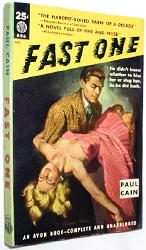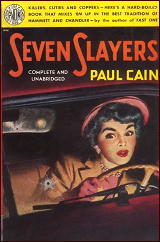Sat 14 Apr 2012
A 1001 MIDNIGHTS Review: PAUL CAIN – Fast One.
Posted by Steve under 1001 Midnights , Pulp Fiction , Reviews[5] Comments
by Bill Pronzini

PAUL CAIN – Fast One. Doubleday Doran & Co., hardcover, 1933. First appeared in serialized form in non-consecutive issues of Black Mask magazine between March and September, 1932. Bond Mystery #10, digest paperback, 1945. Avon #178, pbbk, 1948; Avon #496, ppbk, 1952. Southern Illinois University Press, hardcover, 1978. Popular Library, paperback, “American Fiction” series, 1980. Black Lizard, paperback, 1987.
The hardest of the hard-boiled writers for Black Mask in the early 1930s was unquestionably Paul Cain (Peter Ruric). His style, as pulp authority Ron Goulart has noted, at times “becomes as sparse and clipped as that of a McGuffey’s Reader.”
In an afterword to the Southern Illinois reprint edition, critic Irvin Faust says that Cain “hasn’t the time or patience for excess baggage. He picks up his literary scalpel and scrapes away conjunctions as if they were bad merchandise… He digs into the page with a hard sentence: simple, declarative, exact.”

Fast One is Cain’s only novel. (He was primarily a screenwriter and is responsible for such films as One for the Money, Grand Central Murders, and Mademoiselle Foi.)
It was written on a bet and its various sections first appeared in Black Mask as five self-contained novelettes prior to book publication. It is unrelentingly grim and stark and brutal, to such an extent that it becomes uncomfortable to read; one begins to feel a kind of breathless despair well before the end.

The “hero” is Gerry Kells, a mysterious loner, a criminal who insinuates himself into the Los Angeles underworld and wreaks havoc on its denizens and on others who happen to get in his way. The dust jacket blurb on a 1978 reissue by Southern Illinois University Press says about Kells:

Cain knew his Los Angeles and he knew the ways of its Prohibition and post-Prohibition underworld. The portrait he paints of both, and of Gerry Kells, makes Fast One an important and compulsively readable novel, despite that feeling of breathless despair it engenders.
The only other book by Cain is Seven Slayers (1946), a collection of seven of his other Black Mask stories, all of which are in the same tough vein and all of which are excellent samples of pulp writing at its best.
———
Reprinted with permission from 1001 Midnights, edited by Bill Pronzini & Marcia Muller and published by The Battered Silicon Dispatch Box, 2007. Copyright © 1986, 2007 by the Pronzini-Muller Family Trust.
April 14th, 2012 at 5:10 pm
Boy, am I ever looking forward to my copy !!!
The Doc
April 14th, 2012 at 5:26 pm
For his film fans, wbshop.com recently made GRAND CENTRAL MURDER available as a Made To Order DVD.
April 14th, 2012 at 6:42 pm
Someone who’s actually seen GRAND CENTRAL MURDER can correct me, and they’d better, but from what I know about the film is that it’s like day and night in comparison with FAST ONE.
The movie’s a light mystery comedy, according to what I’ve read about it, with a wisecracking PI as the leading character. He’s married (a la THE THIN MAN), and the police (complete with dopey second-in-charge) think there’s a good chance he did it.
There’s also a bit of a locked room mystery to it, and overall it seems to have a pretty good reputation (6.6 stars on IMDB). I taped it off TCM a long time ago, but why I’ve never watched it, I don’t know.
April 15th, 2012 at 8:47 am
GRAND CENTRAL MURDER is a fairly light murder mystery with some comic elements. It’s certainly not hard-boiled. I rather liked it.
December 4th, 2023 at 11:04 pm
[…] The novel Fast One has been reviewed by Bill Pronzini some time back on this blog. Check it out here. And both the novel and the author are discussed in depth by Walker Martin in his review of The […]